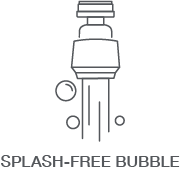Niagara Conservation®
Dual-Threaded Bubble Faucet Aerator, 1.0 GPM

WaterSense® certified for maximum performance. Learn More
Did you know that, beyond saving water, our faucet aerators save you money on heating the water? For your utility bills, the reduced flow rate really does double duty. Plus, the durable plastic screen is easier to clean than traditional metal.
WaterSense® certified for maximum performance.
This faucet aerator:
- Uses only 1.0 GPM
- Provides safer drinking water than other aerators since chrome completely covers the all-brass construction
- Generates a splash-free bubble stream
- Fits most male- and female-threaded faucets (this aerator’s thread sizes: male 15/16”-27, female 55/64”-27)
- Performs well at nearly every water pressure, due to a pressure-compensated stream
- Installs in just a few minutes
Product Warranty: 10 Years
Spray Pattern
This faucet aerator is designed with 1 spray setting: splash-free bubble stream

Flow Rate
A flow rate is the measurement of water per minute that flows out of your faucet aerator. They are usually measured in gallons per minutes or GPM. A standard faucet aerator has a flow rate of 2.2 GPM. This faucet aerator has a maximum flow rate of 1.0 GPM for increased efficiency.

Saving Water Saves Energy
Saving water also saves energy by reducing the amount of energy used to heat water. The savings differ whether you have an electric or natural gas hot-water heater. This faucet aerator is 55% more efficient than a standard 2.2-GPM faucet aerator and can potentially save $37 with natural gas heating utilities per year and $67 with electric heating utilities per year.*

*Factors in calculating savings potential:
-
3-person households each using a faucet 7 minutes per day, 365 days per year (AWWARF Residential Study)
-
Comparing water use with these aerator vs. a standard 2.2 GPM unit
-
US city average water and sewer cost of $8.3 per 1,000 gallons (study done by NUS Consulting Group 2011)
 US Dollar
US Dollar























